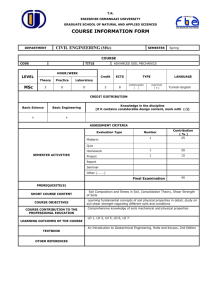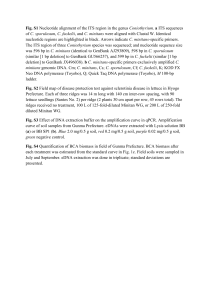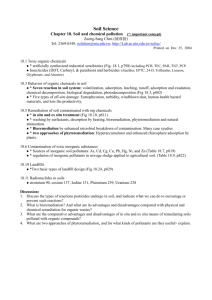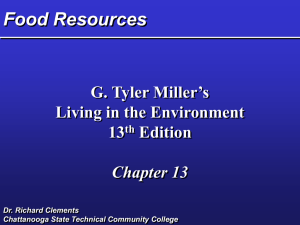Chapter 2
advertisement
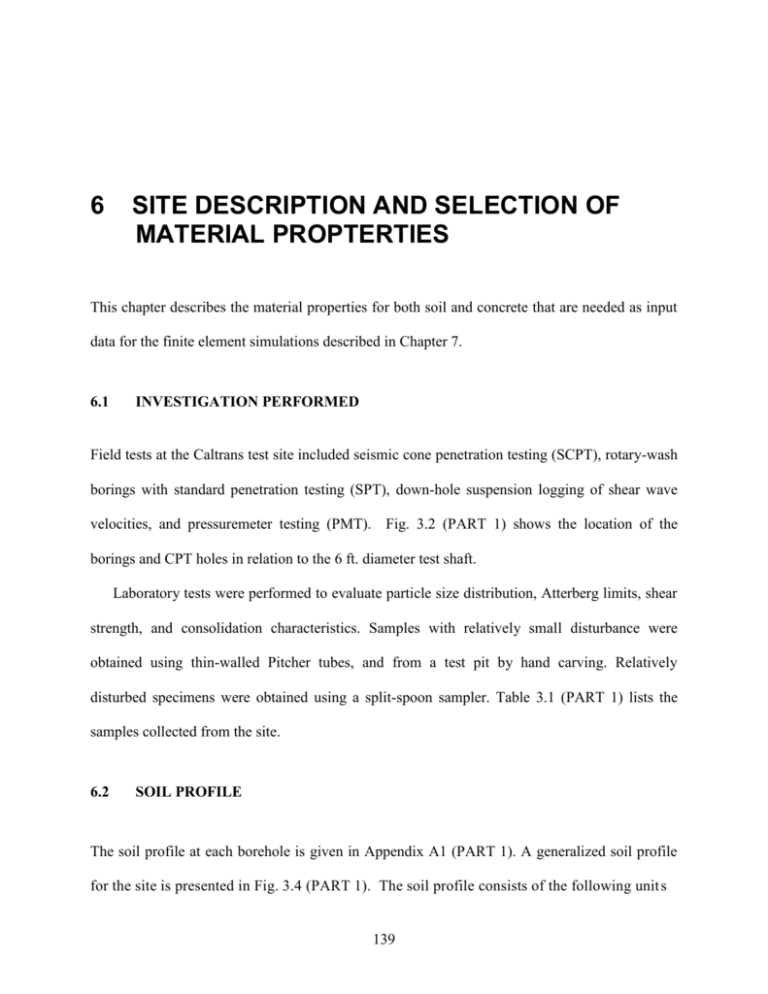
6 SITE DESCRIPTION AND SELECTION OF MATERIAL PROPTERTIES This chapter describes the material properties for both soil and concrete that are needed as input data for the finite element simulations described in Chapter 7. 6.1 INVESTIGATION PERFORMED Field tests at the Caltrans test site included seismic cone penetration testing (SCPT), rotary-wash borings with standard penetration testing (SPT), down-hole suspension logging of shear wave velocities, and pressuremeter testing (PMT). Fig. 3.2 (PART 1) shows the location of the borings and CPT holes in relation to the 6 ft. diameter test shaft. Laboratory tests were performed to evaluate particle size distribution, Atterberg limits, shear strength, and consolidation characteristics. Samples with relatively small disturbance were obtained using thin-walled Pitcher tubes, and from a test pit by hand carving. Relatively disturbed specimens were obtained using a split-spoon sampler. Table 3.1 (PART 1) lists the samples collected from the site. 6.2 SOIL PROFILE The soil profile at each borehole is given in Appendix A1 (PART 1). A generalized soil profile for the site is presented in Fig. 3.4 (PART 1). The soil profile consists of the following unit s 139 (Section 3.1.2, PART 1): Unit 1: Fill consisting of asphalt and concrete debris. The depth is from 0 – 2 to 5 ft. (thickness 0.6 to 1.5 m). Unit 2: Silty clay classified as CL according to USCS. The depth is from the base of Unit 1 to 18 – 24 ft. (5.5 m – 7.3 m). Classification tests indicate approximately 60% fines and PI ~ 15. A silty sand layer with a thickness of 2 ft. (0.6 m) was found at a depth of 12 ft. (3 m) within this unit. Unit 3: Medium- to fine-grained silty sand classified as SM according to USCS. The layer lies below Unit 2, with a thickness of about 2 to 4 ft. (0.6 to 1.2 m). Classification tests indicate 30% fines and PI ~ 12. Unit 4: Silty clay classified as CL according to USCS. The depth is from the base of Unit 3 to 48 ft. (14.6 m). Classification tests indicate 40% fines and PI ~ 13 to 14. A medium sand layer underlies the Unit 4. The groundwater table is located at the top of this layer. 6.3 IN SITU TESTING PROGRAM (a) Standard Penetration Tests Standard Penetration Tests were performed using a split spoon sampler, with no space for brass liners. The hammer was lifted and released by means of a rope and drum system with two turns of the rope around the rotary drum. According to Seed et al. (1985), this hammer release system provides an effective energy ratio of about 60%. Blow counts were corrected for effective 140 vertical stress (N1)60 based on recommendation of Liao and Whittman (1985) and are shown in Fig. 3.4 (PART 1). (b) Seismic Cone Penetration Tests A single SCPT probe (SCPT-1) was performed at the shaft location prior to installation and seven additional SCPT and CPT probes were conducted after shaft installation. Tip resistance (qc), sleeve resistance (fs), friction ratio ( R f qc fs ), and downhole interval shear wave velocities from these tests are provided in Appendix A (PART 1). These values were normalized to dimensionless quantities as follows (Robertson and Wride 1997): Q qc 'vo / Pa Pa 'vo n (6.1) F f s / qc vo .100% (6.2) I c 3.47 log Q 1.22 log F 2 2 0.5 (6.3) where σvo = overburden stress, 'vo = effective overburden stress, and Pa = atmospheric pressure. The exponent n is a function of soil type and ranges from 0.5 to 1.0. Values of Ic < 2.6 indicate that a soil is most likely granular, whereas soils with Ic > 2.6 are likely to be very silty and possibly plastic. Profiles of Q, F, and Ic are presented in Fig. 3.4 (PART 1). (c) Shear Wave Velocity Measurements PVC casing was installed and grouted into the ground after completion of boreholes B1, B2, and B3. An OYO suspension logger operated by Geovision, Inc., was then used to measure shear wave velocities at 1.6 ft. (0.5 m) intervals. Individual velocity profiles are given in Appendix A3 (PART 1). A summary of the measured velocities is presented in Fig. 3.5 (PART 1). The average shear wave velocity for the upper 50 ft. of soil is approximately 1000 ft./s (300 m/sec), which is 141 consistent with the average value measured in the SCPT probes using downhole techniques (Appendix A2, PART 1). (d) Pressuremeter Tests Pressuremeter tests (PMT) based on ASTM D-4719 were conducted at two locations near the test shaft (Fig. 3.2, PART 1). Drilling was conducted by A&W Drilling, Inc. and tests were run under the guidance of Larry Tucker, who has performed many tests at Texas A&M University. A TEXAM pressuremeter (manufactured by Roctest) was placed at each test depth in a pre-drilled borehole. Tests are performed by injecting water under pressure into the pressuremeter. The increase in volume of the probe is measured by the amount of water injected and the injection pressure is monitored. Five tests were performed at each of the two borings at depths of 3 ft. (0.9 m), 11 ft. (3.3 m), 18 ft. (5.5 m), 25 ft. (7.6 m), and 31 ft. (9.5 m). The PMT tests provide an in situ stress-strain curve, relating volumetric expansion (obtained from change in radius, ∆ R ) to injection pressure, P. The field measurements are calibrated and corrected for system compressibility and membrane resistance using the program PRESRED (Tucker and Briaud 1990). The corrected P – ∆R/R0 (where R0 is the initial probe radius) relationship for each test is presented in Appendix C (PART 1). The results of the PMT tests were used to estimate p-y curves, undrained shear strength of the soil, and elastic modulus of the soil. In situ PMT p-y curves were also generated using the approach of Briaud et al. (1985), which has been coded into the computer program PYPMT (Little et al. 1987). These curves are provided in Section 5.5.1 (PART 1). The undrained shear strength Su was calculated based on the limit pressure method (Menard 1970): 142 Su PL (6.4) where β ~ 7.5 is recommended by Briaud (1986) and PL is the ultimate pressure from the pressuremeter test (Fig. 6.1). PMT S u values are given in Fig. 3.4 (PART 1) and are considered more reliable than the values obtained from UU testing (see Section 6.3c). The elastic modulus can also be calculated from a P – ∆R/R0 relationship. The initial elastic modulus E0 is calculated using the equation given in Fig. 6.1, which is based on the expansion of an infinitely long cylinder in an isotropic homogeneous elastic space. This theory assumes that the soil has the same E0 in compression and in tension. However, typical soil has a much larger Young’s modulus E+ in compression and a smaller, if any, Young’s modulus E- in tension. In cylindrical expansion, compressive stresses occur in the radial direction while tensile stresses occur in circumferential direction. For most soils, E0 is 2 to 3 times lower than the compression modulus E+ (Briaud 1986). 6.4 LABORATORY TESTING PROGRAM (a) Classification Tests Sieve, hydrometer, and Atterberg limit tests were performed on specimens as noted in Table 3.1 (PART 1) according to ASTM D-421, D-422, and D-4318, respectively. Test results are summarized in Table 6.1. (b) Consolidation Tests Consolidation tests were performed on clayey specimens from samples P1-3, P1-4, P1-5, P1-6, P3-2, and P3-4 according to ASTM D-2435. Laboratory consolidation curves for each test are provided in Appendix B (PART 1). A summary of the test results is given in Table 6.2 and a 143 Fig. 6.1 Typical preboring pressuremeter curve (Briaud 1986). 144 Table 6.1 Summary of classification test results Sample P1-5 P1-6 S1-1 S1-3 S1-4 S2-1 S2-3 P3-4 S3-1 S3-2 TP-E2 TP-E3 TP-E4 TP-E5 TP-S2 TP-S3 TP-S5 TP-W2 TP-W3 TP-W4 TP-W5 Depth (ft.) Liquid Plastic Plastic Water USCS Limit Limit Index Content Classification (%) (%) (%) (%) 34 41 37 30 21 50 34 67 34 35 43 33 30 21 27 25 20 20 21 20 32 19 16 17 17 20 13 14 12 10 1 29 14 35 15 19 26 16 10 27.4 24.6 21.3 26 21.3 19.7 20.8 18.9 25.7 20.1 19.1 22.3 20.8 23 29 36 11 24 26 14 25 36 12 26 4 5 10 10 5 9 5 4 8 4 9 CL ML CL CL ML CL CL CH CL CL CL CL CL Table 6.2 Summary of consolidation test results Upper Sample Depth v (psf) 'p (psf) Cc Cr (ft.) cv (ft2/yr) bound OCR P1-3 15 1800 6300 0.3004 0.0162 - 3.5 P1-4 19 2280 10944 0.2324 0.0176 200 to 250 4.8 P1-5 29 3480 3480 0.1311 0.0176 - 1.0 P1-6 36 4320 4320 0.2577 0.0260 - 1.0 P3-2 10 1200 7080 0.3219 0.0493 200 to 250 5.9 P3-4 36 4320 4320 0.1805 0.0266 200 to 600 1.0 145 typical time-settlement curve is shown in Fig. 6.2. Overconsolidation ratios (OCRs) in the upper portion of the clay [depth < about 24 ft (7.3 m)] are uncertain because of unknown negative pore pressures. The distributions of vertical total stress and preconsolidation stress vs. depth are shown in Fig. 3.4 (PART 1). Assuming zero pore pressures above the groundwater table, upper bound values of OCR range from 3.5 to 5.9. The clays are nearly normally consolidated (OCR ~ 1) at depths > 24 ft. (7.3 m). As indicated in Table 6.2, coefficients of consolidation (cv) in the overconsolidated and normally consolidated clays are approximately 200-250 ft2/yr (18.6-23.25 m2/yr) and 200-600 ft2/yr (18.6-55.8 m2/yr), respectively. Time (min) 0.1 1 10 100 1000 10000 0.15 Dial Reading (inches) 0.16 0.17 0.18 0.19 0.2 0.21 0.22 Fig. 6.2 Dial readings vs. time for consolidation test P1-5 (Δσv = 500 psf). The consolidation test data can be used to estimate the range of consolidation that may have occurred within the soil during the course of lateral load testing for the 6 ft. diameter shaft. If we assume a total testing time t and a maximum drainage path length Hdr, the time factor T for the normally consolidated soil (cv = 250 ft2/yr) is, T cvt H dr2 (6.5) 146 The unknown in equation (6.5) is the time t. Two extreme cases can be considered. If t is equal to the total testing time of 3 weeks and Hdr = 2D = 12 ft., then T = 0.10 and the average degree of consolidation U is 36%. If, however, t is taken at the time for a single load increment in the field (approximately 30 min.) and Hdr = D = 6 ft., then T = 0.0004 and U = 2%. The actual amount of soil consolidation is almost certainly between these two extreme values, suggesting that the soil surrounding the shaft is best modeled using an effective stress analysis with partial drainage (i.e., consolidation/swelling) taken into account. (c) Unconsolidated-Undrained (UU) Triaxial Tests UU triaxial testing of clay soils from samples P1-3, P1-4, P3-1, and P3-4 was conducted according to the procedure recommended in ASTM D-2850. Specimens were hand-carved from Pitcher tube samples to an approximate diameter of 1.3 inches (33 mm) and height of 3 inches (76 mm). Loads were increased at a constant strain rate of 0.009 in/min (0.23 mm/min), yielding a typical time-to-failure of 2 minutes. Detailed results from the UU tests are provided in Appendix B (PART 1). Test results are summarized in Table 6.3, where σult is the ultimate deviator stress and ∆σdf is the deviator stress at failure. These results indicate the clay has low sensitivity (< 2). Failure strains εf were small (0.6% to 1%) and values of ε50 were approximately 0.3% to 0.5%. It was also found that the undrained strengths inferred from pressuremeter tests are sometimes higher than those from the UU tests. One possible explanation is that only specimens with relatively high clay content could be prepared for triaxial testing, as relatively sandy specimens (having potentially higher strength) de-aggregated during sample trimming. Another reason could be relatively high matric suction in the in situ soil, (S = 86% to nearly 100% in the tested clay specimens, with an average of 91%). 147 The laboratory tests were performed several months after the field drilling, which may cause a partial loss of matric suction in the soil specimens (Section 3.1.4, PART 1). Table 6.3 Summary of UU triaxial test results on clayey soils 6.5 Sample Depth (ft.) σult (psf) ∆σdf (psf) εf (%) P3-1 7 6500 8000 3 P1-3 15 5500 6000 2.5 P1-4 19 4000 5000 2 P3-4 36 5000 6000 2 SELECTION OF SOIL PROPERTIES FOR ABAQUS SIMULATIONS Several soil constitutive models are available in ABAQUS. The Mohr-Coulomb model has been chosen for simulations in this thesis. The Mohr-Coulomb model uses the classic Mohr-Coulomb yield criteria. Failure occurs when the shear stress on any plane in the material reaches a value that depends linearly on the normal stress on the same plane. The ABAQUS Mohr-Coulomb model is not identical to the classical Mohr-Coulomb model because ABAQUS uses a different flow potential. The ABAQUS Mohr-Coulomb model uses a smooth flow potential that matches the classical Mohr-Coulomb surface only at the triaxial extension and compression meridians (not in plane strain). Fig. 6.3 shows the Mohr-Coulomb failure model. The ABAQUS Mohr-Coulomb model requires the following input soil parameters: Poisson’s ratio E : Young’s modulus c : cohesion intercept angle of internal friction (in degrees) 148 c Fig. 6.3 Mohr-Coulomb failure model. dilation angle (in degrees) according to laboratory tests for soil, pcf). (2) it is reasonable to assume that 0.3 under drained conditions and 0.5 under undrained conditions. Since ABAQUS has convergence problems for 0.5, 0.46 was used for the undrained simulations. (3) E: Young’s modulus can be obtained from consolidation tests, PMT tests, and shear wave velocity profiles. E from consolidation tests: Fig. 6.4 shows the compressibility curve from consolidation test P1-5. The slope of line BC is the recompression index Cr, which can be defined for elastic media as (Whitman 1969), Cr (1 e) v 0.43D ' (6.6) 149 where e = average void ratio from B to C, v ' = average effective stress from B to C, and the constrained modulus D is, D E 1 1 1 2 (6.7) Combining Eqs. 6.6 and 6.7 gives, E (1 e)(1 )(1 2 ) v ' 0.43(1 )Cr (6.8) Table 6.4 shows E values as obtained from consolidation tests for the clay soils at the Caltrans site. 0.74 0.72 A Void Ratio 0.7 0.68 0.66 0.64 0.62 C B 0.6 0.58 1000 10000 Pressure (psf) Fig. 6.4 Void ratio vs log pressure for consolidation test P1-5. 150 100000 E from pressuremeter tests: Fig. 6.5 shows a typical P - ∆R/R0 curve obtained from PMT tests conducted at the Caltrans site. Briaud (1986) developed the following formula to calculated E from PMT data, R R P2 P1 E (1 ) 1 R0 1 R0 R R R0 2 R0 1 where (6.9) R = the ratio of change in radius to initial radius and P = injection pressure. Initial R0 modulus E0 can be obtained by applying this formula to AB, while reload modulus Er can be obtained by applying it to CD. Table 6.5 shows E0 and Er values obtained from pressurement tests conducted for this project. 30 Pressure on Cavity Wall (ksf) 25 20 D 15 B 10 C 5 A 0 0 5 10 15 20 25 30 Relative Increase in Probe Radius, dR/Ro (%) Fig. 6.5 P - ∆R/R0 curve for PMT-1 at a depth of 11 ft. 151 35 40 E from shear wave velocity profiles: Young’s modulus can also be calculated from shear wave velocity using elastic theory, E 2G1 2 Vs (1 ) 2 (6.10) where Vs = shear wave velocity, G = shear modulus, and = soil density. Table 6.6 shows E values calculated from suspension logging shear wave velocities using 0.3. Table 6.4 E values based on consolidation data Test Depth (ft.) OCR e v' (psf) Cr E (psf) P1-3 15 3.5 0.39 6400 0.0162 9.48×105 P1-5 29 2.5 0.61 6400 0.0175 1.02×106 P1-6 36 1.4 0.70 6400 0.0260 7.23×105 Table 6.5 E values based on PMT curves Test Depth (ft.) E0 (psf) Er (psf) PMT-1 11 4.7×105 5.5×106 PMT-1 18 5.2×105 1.4×106 PMT-1 25 3.8×105 1.35×106 PMT-1 31 6.3×105 1.35×106 Table 6.6 E values obtained from shear wave velocities Depth (ft.) B1 B2 B3 Vs (ft/s) E (psf) Vs (ft/s) E (psf) Vs (ft/s) E (psf) 9.8 1052 1.07×107 802 6.24×106 1155 1.29×107 19.7 896 7.79×106 1131 1.24×107 1048 1.07×107 29.5 1055 1.08×107 1019 1.01×107 911 8.05×106 39.4 1003 9.76×106 1038 1.05×107 965 9.04×106 49.4 1093 1.16×107 1101 1.18×107 1019 1.01×107 152 Choice of E values for ABAQUS simulations The laboratory and field test data for equivalent values of Young’s modulus of the soil layers shows a wide range. This variability is attributed to the different strain levels involved in the tests and disturbance effects for the laboratory tests. The most reliable and applicable data are Gmax from shear wave velocities and Er from PMT tests. Based on Appendix A2 and A3 (PART 1), it is estimated that the soil in top 4 ft. of the Caltrans site has an average shear wave velocity Vs of 700 ft/sec. The shear wave velocity below 4 ft. is approximately 1000 ft/sec. Assuming that G = 0.8Gmax, the corresponding E values above and below a depth of 4 ft. are 4 × 106 psf and 8 × 106 psf, respectively. Based on the different strain levels at soil layers and a probable range of E values, three sets of simulations were conducted using ABAQUS: 1) upper bound E values, 2) lower bound E values and 3) average E values. Table 6.7 lists the E values that were used for each set of simulations. Table 6.7 Soil modulus values used for ABAQUS simulations Depth Lower bound E Average E Upper bound E (ft.) (psf) (psf) (psf) 0-4 2×106 2×106 2×106 >4 2×106 5×106 8×106 (4) Shear strength parameters and dilation angle The whole soil-shaft system has to be simulated as undrained due to the facts 1) ABAQUS can not deal with partial drainage together with soil-shaft contact, and 2) there are no reliable drained parameters available for the clay from laboratory or field tests. For undrained clay, c = Su and Su profile obtained from UU triaxial tests and PMT. 153 For drained sand, c = 0, and (N1)60. Based on the (N1)60 for the sand layer (Unit 3, Fig. 3.4, PART 1), it is reasonable to choose . The soil profiles used for the ABAQUS simulations in Chapter 7 are shown in Figs. 6.7, 6.7 and 6.8. Undrained shear strengths are specified for the fill and clay layers (Units 1, 2, and 4) and drained shear strength parameters are specified for the sand layer (Unit 3). A 0.3 ft. thick asphalt layer is included at a depth of 3 ft and has been assigned a shear strength equal to twice that of the surrounding fill. 6.6 SELECTION OF REINFORCED CONCRETE PROPERTIES FOR ABAQUS SIMULATIONS Reinforced concrete behavior can be simulated in ABAQUS using a reinforced concrete model, which can account for the distribution of concrete and steel within a shaft. This model, however, generated serious convergence problems in the simulations, especially when a soil/shaft contact surface was included. Consequently, the ABAQUS reinforced concrete model was not used for the current study. A simplified analysis procedure was used to simulate the nonlinear behavior of the shaft. The s ha ft i s t r ea t e d as an e qui v al ent l i n e a r m at eri al t h at h as t he s am e m om en t curvature relationship as that for a real reinforced concrete shaft. EI values for the shaft change with curvature and are obtained from a calculated moment-curvature (M- ) relationship that closely matches field measurements (Fig. 6.9 and Table 6.8). EI dM for a uniform elastic d column. I values were calculated using the gross geometry of the shaft (i.e., I r 4 4 ) and the unit weight of the reinforced concrete was pcf. ABAQUS simulations have been performed 154 155 Fig. 6.6 Problem geometry and soil profile with upper bound E values 156 Fig. 6.7 Problem geometry and soil profile with lower bound E values 157 Fig. 6.8 Problem geometry and soil profile with average E values by manual iteration such that the E value assigned for each shaft element corresponds to the moment carried by that element. Iterations are conducted using the following steps: 1) Assign initial E value to each shaft element based on the expected moment for the element. 2) Run the ABAQUS simulation with staged loading as described in Section 7.3. 2 3) Calculate curvature ( d y dz 2 ) for all nodes along the shaft. Fig. 6.10 shows a deformed shaft, in which z is the length below the top of the shaft and y is the lateral displacement. Based on the y and z coordinates provided by ABAQUS, the slope yi ' at point Pi is determined as, dy y yi 1 yi 1 yi yi ' i /2 dz i zi zi 1 zi 1 zi (6.11) and the curvature i is calculated as d 2 y dy ' yi ' yi 1 ' yi 1 ' yi ' 2 i 2 dz dz z z z z i i i 1 i i i 1 (6.12) 4) Based on the curvature from step 3) and curvature-E relationship listed in Table 6.8, calculate corresponding E value for each element. 5) If the E values assigned at step 1) and calculated from step 4) match for each element, iteration ends. If not, reassign new E values for the elements. 6) Repeat step 2) to step 5) until convergence is achieved. 158 2.00E+05 1.80E+05 1.60E+05 Moment (in.-kips) 1.40E+05 1.20E+05 1.00E+05 EI 8.00E+04 1 6.00E+04 Numerical prediction for 72'' Shaft Numberical prediction for 78'' Shaft 4.00E+04 Field measurement (Janoyan report, 2001) 2.00E+04 0.00E+00 0.00E+00 2.00E-04 4.00E-04 6.00E-04 8.00E-04 1.00E-03 Curvature (1/in.) Fig. 6.9 Moment-curvature relationship for 6 ft. diameter shaft. 159 1.20E-03 Table 6.8 Value of E for moment-curvature relationship shown in Fig. 6.9 6.5 ft. Diameter Shaft Moment Curvature E (kips-in.) (1/in.) (psf) 6 ft. Diameter Shaft Moment Curvature E (kips-in.) (1/in.) (psf) 1.19E+04 5.13E-06 1.84E+08 1.10E+04 4.94E-06 2.43E+08 2.39E+04 9.95E-06 1.91E+08 2.19E+04 1.05E-05 2.29E+08 3.55E+04 1.49E-05 1.89E+08 3.26E+04 1.57E-05 2.27E+08 4.70E+04 1.99E-05 1.87E+08 4.32E+04 2.06E-05 2.29E+08 5.84E+04 2.49E-05 1.86E+08 5.36E+04 2.58E-05 2.27E+08 6.98E+04 2.94E-05 1.88E+08 6.39E+04 3.05E-05 2.29E+08 8.06E+04 3.43E-05 1.86E+08 7.39E+04 3.56E-05 2.27E+08 9.12E+04 3.92E-05 1.85E+08 8.37E+04 4.06E-05 2.25E+08 1.02E+05 4.41E-05 1.83E+08 9.35E+04 4.54E-05 2.25E+08 1.12E+05 4.83E-05 1.84E+08 1.03E+05 5.01E-05 2.25E+08 1.27E+05 5.88E-05 1.71E+08 1.17E+05 6.10E-05 2.09E+08 1.35E+05 7.07E-05 1.52E+08 1.25E+05 7.32E-05 1.87E+08 1.41E+05 8.34E-05 1.34E+08 1.32E+05 8.56E-05 1.68E+08 1.47E+05 9.53E-05 1.22E+08 1.36E+05 9.92E-05 1.49E+08 1.51E+05 1.09E-04 1.10E+08 1.40E+05 1.13E-04 1.36E+08 1.54E+05 1.21E-04 1.01E+08 1.44E+05 1.26E-04 1.25E+08 1.56E+05 1.35E-04 9.21E+07 1.46E+05 1.41E-04 1.13E+08 1.59E+05 1.47E-04 8.55E+07 1.49E+05 1.54E-04 1.05E+08 1.60E+05 1.60E-04 7.95E+07 1.50E+05 1.69E-04 9.71E+07 1.62E+05 1.71E-04 7.52E+07 1.52E+05 1.82E-04 9.09E+07 1.67E+05 2.30E-04 5.74E+07 1.59E+05 2.47E-04 7.01E+07 1.69E+05 2.85E-04 4.69E+07 1.62E+05 3.12E-04 5.66E+07 1.68E+05 3.34E-04 4.00E+07 1.64E+05 3.68E-04 4.87E+07 1.66E+05 3.77E-04 3.50E+07 1.64E+05 4.22E-04 4.25E+07 1.66E+05 4.17E-04 3.15E+07 1.65E+05 4.74E-04 3.80E+07 1.65E+05 4.54E-04 2.88E+07 1.67E+05 5.25E-04 3.47E+07 1.65E+05 4.97E-04 2.63E+07 1.69E+05 5.78E-04 3.18E+07 1.66E+05 5.84E-04 2.25E+07 1.71E+05 6.83E-04 2.73E+07 1.68E+05 6.71E-04 1.99E+07 1.73E+05 7.84E-04 2.42E+07 1.70E+05 7.64E-04 1.77E+07 1.76E+05 8.89E-04 2.16E+07 1.73E+05 8.56E-04 1.60E+07 1.78E+05 1.00E-03 1.95E+07 1.75E+05 9.51E-04 1.46E+07 1.81E+05 1.10E-03 1.79E+07 160 y O Pi-1 (yi-1, zi-1) Pi (yi, zi) Pi+1 (yi+1, zi+1) Deformed Shaft z Fig. 6.10 Deformed shaft with nodes and coordinates. 161 162
